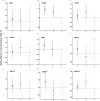Impact of Skin Care Products on Phthalates and Phthalate Replacements in Children: the ECHO-FGS
- PMID: 39230332
- PMCID: PMC11373421
- DOI: 10.1289/EHP13937
Impact of Skin Care Products on Phthalates and Phthalate Replacements in Children: the ECHO-FGS
Erratum in
-
Erratum: "Impact of Skin Care Products on Phthalates and Phthalate Replacements in Children: The ECHO-FGS".Environ Health Perspect. 2024 Nov;132(11):119001. doi: 10.1289/EHP16591. Epub 2024 Nov 19. Environ Health Perspect. 2024. PMID: 39560635 Free PMC article. No abstract available.
Abstract
Background: Phthalates and their replacements have been implicated as developmental toxicants. Young children may be exposed to phthalates/replacements when using skin care products (SCPs).
Objectives: Our objective is to assess the associations between use of SCPs and children's urinary phthalate/replacement metabolite concentrations.
Methods: Children (4-8 years old) from the Environmental Influences on Child Health Outcomes-Fetal Growth Study (ECHO-FGS) cohort provided spot urine samples from 2017 to 2019, and mothers were queried about children's SCP use in the past 24 h (). Concentrations of 16 urinary phthalate/replacement metabolites were determined by liquid chromatography-tandem mass spectrometry (). We used linear regression to estimate the child's use of different SCPs as individual predictors of urinary phthalate/replacement metabolites, adjusted for urinary specific gravity, age, sex assigned at birth, body mass index, and self-reported race/ethnic identity, as well as maternal education, and season of specimen collection. We created self-organizing maps (SOM) to group children into "exposure profiles" that reflect discovered patterns of use for multiple SCPs.
Results: Children had lotions applied (43.0%) frequently, but "2-in-1" hair-care products (7.5%), sunscreens (5.9%), and oils (4.3%) infrequently. Use of lotions was associated with 1.17-fold [95% confidence interval (CI): 1.00, 1.34] greater mono-benzyl phthalate and oils with 2.86-fold (95% CI: 1.89, 4.31) greater monoethyl phthalate (MEP), 1.43-fold (95% CI: 1.09, 1.90) greater monobutyl phthalate (MBP), and 1.40-fold (95% CI: 1.22, 1.61) greater low-molecular-weight phthalates (LMW). Use of 2-in-1 haircare products was associated with 0.84-fold (95% CI: 0.72, 0.97) and 0.78-fold (95% CI: 0.62, 0.98) lesser mono(3-carboxypropyl) phthalate (MCPP) and MBP, respectively. Child's race/ethnic identity modified the associations of lotions with LMW, oils with MEP and LMW, sunscreen with MCPP, ointments with MEP, and hair conditioner with MCPP. SOM identified four distinct SCP-use exposure scenarios (i.e., profiles) within our population that predicted 1.09-fold (95% CI: 1.03, 1.15) greater mono-carboxy isononyl phthalate, 1.31-fold (95% CI: 0.98, 1.77) greater mono-2-ethyl-5-hydroxyhexyl terephthalate, 1.13-fold (95% CI: 0.99, 1.29) greater monoethylhexyl phthalate, and 1.04-fold (95% CI: 1.00, 1.09) greater diethylhexyl phthalate.
Discussion: We found that reported SCP use was associated with urinary phthalate/replacement metabolites in young children. These results may inform policymakers, clinicians, and parents to help limit children's exposure to developmental toxicants. https://doi.org/10.1289/EHP13937.
Figures



References
MeSH terms
Substances
Grants and funding
- HHSN275200800014C/HD/NICHD NIH HHS/United States
- U2C ES026553/ES/NIEHS NIH HHS/United States
- R21 AR084039/AR/NIAMS NIH HHS/United States
- HHSN275200800002C/HD/NICHD NIH HHS/United States
- HHSN275200800012C/HD/NICHD NIH HHS/United States
- HHSN275200800003I/HD/NICHD NIH HHS/United States
- UG3 OD023316/OD/NIH HHS/United States
- HHSN275200800003C/HD/NICHD NIH HHS/United States
- HHSN275201000009C/HD/NICHD NIH HHS/United States
- U2C ES026555/ES/NIEHS NIH HHS/United States
- HHSN275200800002I/HD/NICHD NIH HHS/United States
- HHSN275200800028C/HD/NICHD NIH HHS/United States
- HHSN275200800013C/HD/NICHD NIH HHS/United States
- UG3 OD035543/OD/NIH HHS/United States
LinkOut - more resources
Full Text Sources
Miscellaneous

